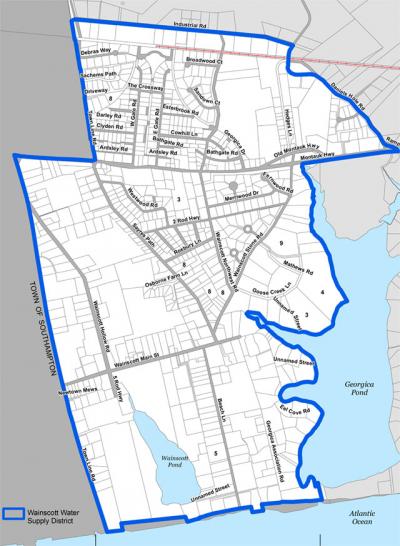Wainscott Water District Expanded

A water supply district to be created in Wainscott, which will allow the Suffolk County Water Authority to extend water mains to residences that rely on wells that are, or could be, contaminated with perfluorinated chemicals, which have been detected around East Hampton Airport, will encompass 872 properties, it was announced at the East Hampton Town Board meeting on Tuesday.
The area includes properties surveyed in two rounds of testing following the initial discovery of these chemicals in wells around the airport, as well as additional parcels not included in those tests. Its parameters are based on additional detection of the carcinogenic compounds and modeling of groundwater flow, Marguerite Wolffsohn, the town’s director of planning, told the board.
The proposed district extends south to the Atlantic Ocean, east to Daniel’s Hole Road and Georgica Pond, west to Town Line Road, and north to Industrial Road.
Supervisor Peter Van Scoyoc said the area had been expanded “to ensure public confidence in the quality of drinking water, and the fact that irrigation wells can draw contaminants outside of normal flow.”
Ms. Wolffsohn told the board that plans for the water supply district were moving quickly, but Councilman Jeffrey Bragman, the board’s liaison to the Wainscott Citizens Advisory Committee, wasn’t satisfied. Mr. Bragman has urged his board colleagues to provide “point-of-entry” treatment systems to affected residents. Mr. Van Scoyoc, however, thinks that doing so would be problematic, citing a state comptroller’s legal opinion that a municipality cannot commit public funds to private treatments.
“I want to take issue with the idea that it’s illegal to do that as a gift,” Mr. Bragman, who is himself a lawyer, said, his frustration clearly growing about his colleagues’ hesitation. A November letter from the State Department of Environmental Conservation to the board, he said, “directed us to install” such systems, or provide an alternative means of supplying public water. Bottled water must also be provided, the D.E.C. letter stated, which the town is doing.
Going further, Mr. Bragman said the town has the right to declare a public health emergency and act under that authority to provide in-home filtration where wells are contaminated. He cited a 1982 opinion by the state attorney general at the time, Robert Abrams, concerning suspected carcinogens detected in a sole-source aquifer as the basis to declare such an emergency.
“It’s high time we do more to help them out,” Mr. Bragman said of affected residents. He referred, as he has previously, to the town’s removing trees on private property to combat pine-beetle infestation.
“This is a much more serious health emergency. . . . I say it’s time to act. We have authority by declaring an emergency.” He suggested that the board set aside $300,000 in surplus funds to provide grants to residents who choose to install point-of-entry treatment systems. “I believe under the law that we have the power,” he said.
What is considered legal contamination and what rises to the level of an emergency is an important distinction, the supervisor said. It’s more important to ensure that any future contamination is addressed, he said, and “the only way to do that is to have a district-wide water supply. I think to be as expedient as we possibly can to bring public water to Wainscott has to be goal number one. We are working on that.”
“But time is wasting!” Mr. Bragman said, following further back-and-forth discussion about providing in-home filtration systems as the water-main extension project is planned and executed. The water-main extension, he predicted, will take many months to accomplish. “There’s an interim step we can take that will enable people to protect themselves now,” he said.
Perfluorooctane sulfonate, or PFOS, and perfluorooctanoic acid, or PFOA, have been identified by the Environmental Protection Agency as “contaminants of emerging concern.” They were among six compounds detected in wells in the vicinity of the airport last year.
Meanwhile, whatever project the town undertakes will be costly. The town is working with the Suffolk County Water Authority to submit an inter-municipal grant application to the state. The deadline for the application is late next month, Ms. Wolffsohn said, and the water supply district must be established before the application can be submitted. The creation of the district would also be subject to public hearing, which could be scheduled as soon as June 3, and review by the state comptroller.
Extending the water mains and connecting them to the necessary properties will cost an estimated $23.6 million, Ms. Wolffsohn said. The grant would cover $10 million of that cost.
Should the board authorize a water supply district following a public hearing, “We’ve been told that the Suffolk County Water Authority could immediately begin” extending water mains, Mr. Van Scoyoc said. The goal is to complete the extensions and connection to residential properties “in the least amount of time.”
